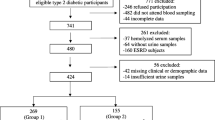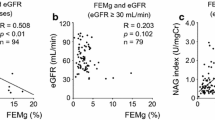Abstract
Background
Proteinuria is broadly classified into glomerular and tubular proteinuria. Urinary beta-2-microglobulin (β2-MG) is known as a marker for detecting tubulointerstitial diseases. However, tubulointerstitial damage can also lead to an increase in urinary β2-MG level in some patients with glomerular diseases. This study aimed to determine the ratio of urinary β2-MG to total protein (TP) concentration in patients with both isolated tubulointerstitial and glomerular disease.
Methods
This multicenter, retrospective study included children with Dent disease or lupus nephritis in five facilities. Their urinary β2-MG levels were > 1000 µg/L. Urinary β2-MG and TP concentrations were obtained, and the ratio of urinary β2-MG to TP concentration (µg/mg) was calculated. The Mann–Whitney U test was performed to compare this ratio between these children. The optimal cutoff value of the ratio for considering the presence of glomerular disease was obtained from the receiver operating characteristic (ROC) curve.
Results
We obtained information on 23 children with Dent disease and 14 children with lupus nephritis. The median ratios of urinary β2-MG to TP concentrations in children with Dent disease and lupus nephritis were 84.85 and 1.59, respectively. The ROC curve yielded the optimal cutoff value of this ratio for distinguishing between these diseases, and the cutoff value was found to be 22.3.
Conclusion
In children with tubulointerstitial diseases, the urinary β2-MG concentration may be approximately 8.5% of the TP concentration. The possibility of presenting with glomerular disease should be considered in patients with a ratio of urinary β2-MG to TP concentration of < 22.3 (µg/mg).


Similar content being viewed by others
Data availability
The datasets are available from the corresponding author upon reasonable request.
Change history
11 May 2023
The original version is updated due to spell error "microgobulin" which appeared inadvertently in the Article title, Abstract and keywords.
References
Hogg RJ, Portman RJ, Milliner D, et al. Evaluation and management of proteinuria and nephrotic syndrome in children: recommendations from a pediatric nephrology panel established at the national kidney foundation conference on proteinuria, albuminuria, risk, assessment, detection, and elimination (PARADE). Pediatrics. 2000;105:1242–9.
D’Amico G, Bazzi C. Pathophysiology of proteinuria. Kidney Int. 2003;63:809–25.
Regeniter A, Freidank H, Dickenmann M, Boesken WH, Siede WH. Evaluation of proteinuria and GFR to diagnose and classify kidney disease: systematic review and proof of concept. Eur J Intern Med. 2009;20:556–61.
Peterson PA, Evrin PE, Berggård I. Differentiation of glomerular, tubular, and normal proteinuria: determinations of urinary excretion of beta-2-macroglobulin, albumin, and total protein. J Clin Invest. 1969;48:1189–98.
Tomlinson PA. Low molecular weight proteins in children with renal disease. Pediatr Nephrol. 1992;6:565–71.
Portman RJ, Kissane JM, Robson AM. Use of β2 microglobulin to diagnose tubulo-interstitial renal lesions in children. Kidney Int. 1986;30:91–8.
Tomlinson PA, Dalton RN, Hartley B, Haycock GB, Chantler C. Low molecular weight protein excretion in glomerular disease: a comparative analysis. Pediatr Nephrol. 1997;11:285–90.
Baines RJ, Brunskill NJ. Tubular toxicity of proteinuria. Nat Rev Nephrol. 2011;7:177–80.
Hibi Y, Uemura O, Nagai T, et al. The ratios of urinary β2-microglobulin and NAG to creatinine vary with age in children. Pediatr Int. 2015;57:79–84.
Devuyst O, Thakker RV. Dent’s disease. Orphanet J Rare Dis. 2010;5:28.
Sekine T, Komoda F, Miura K, et al. Japanese Dent disease has a wider clinical spectrum than Dent disease in Europe/USA: genetic and clinical studies of 86 unrelated patients with low-molecular-weight proteinuria. Nephrol Dial Transplant. 2014;29:376–84.
Tan EM, Cohen AS, Fries JF, et al. The 1982 revised criteria for the classification of systemic lupus erythematosus. Arthritis Rheum. 1982;25:1271–7.
Hochberg MC. Updating the American college of rheumatology revised criteria for the classification of systemic lupus erythematosus. Arthritis Rheum. 1997;40:1725.
Uemura O, Nagai T, Ishikura K, et al. Creatinine-based equation to estimate the glomerular filtration rate in Japanese children and adolescents with chronic kidney disease. Clin Exp Nephrol. 2014;18:626–33.
Weening JJ, D’Agati VD, Schwartz MM, et al. The classification of glomerulonephritis in systemic lupus erythematosus revisited. Kidney Int. 2004;65:521–30.
Uemura O, Nagai T, Ishikura K, et al. Reference glomerular filtration rate levels in Japanese children: using the creatinine and cystatin C based estimated glomerular filtration rate. Clin Exp Nephrol. 2015;19:683–7.
Ikezumi Y, Honda M, Matsuyama T, et al. Establishment of a normal reference value for serum β2 microglobulin in Japanese children: reevaluation of its clinical usefulness. Clin Exp Nephrol. 2013;17:99–105.
Donadio C, Lucchesi A, Ardini M, Giordani R, Cystatin C. beta 2-microglobulin, and retinol-binding protein as indicators of glomerular filtration rate: comparison with plasma creatinine. J Pharm Biomed Anal. 2001;24:835–42.
Donaldson MD, Chambers RE, Woolridge MW, Whicher JT. Alpha 1-microglobulin, beta 2-microglobulin and retinol binding protein in childhood febrile illness and renal disease. Pediatr Nephrol. 1990;4:314–8.
Norden AG, Scheinman SJ, Deschodt-Lanckman MM, et al. Tubular proteinuria defined by a study of Dent’s (CLCN5 mutation) and other tubular diseases. Kidney Int. 2000;57:240–9.
Zhang H, Wang F, Xiao H, Yao Y. The ratio of urinary α1-microglobulin to microalbumin can be used as a diagnostic criterion for tubuloproteinuria. Intractable Rare Dis Res. 2018;7:46–50.
Smith ER, Cai MM, McMahon LP, Wright DA, Holt SG. The value of simultaneous measurements of urinary albumin and total protein in proteinuric patients. Nephrol Dial Transplant. 2012;27:1534–41.
Ohisa N, Kanemitsu K, Matsuki R, et al. Evaluation of hematuria using the urinary albumin-to-total-protein ratio to differentiate glomerular and nonglomerular bleeding. Clin Exp Nephrol. 2007;11:61–5.
Abitbol CL, Chandar J, Onder AM, et al. Profiling proteinuria in pediatric patients. Pediatr Nephrol. 2006;21:995–1002.
Lun A, Suslovych M, Drube J, et al. Reliability of different expert systems for profiling proteinuria in children with kidney diseases. Pediatr Nephrol. 2008;23:285–90.
Davey PG, Gosling P. Beta 2-microglobulin instability in pathological urine. Clin Chem. 1982;28:1330–3.
Funding
No funding was received for conducting this study.
Author information
Authors and Affiliations
Contributions
All authors contributed to the study conception and design. Material preparation, data collection, and analysis were performed by TN, OU, and SH. The first draft of the manuscript was written by TN, and all authors commented on previous versions of the manuscript. All authors read and approved the final manuscript.
Corresponding author
Ethics declarations
Conflict of interest
The authors declare that there are no conflicts of interest.
Ethical approval
All procedures performed in studies involving human participants were in accordance with the ethical standards of the institutional research committee at which the studies were conducted (IRB approval number: 2018038) and with the 1964 Helsinki declaration and its later amendments or comparable ethical standards.
Informed consent
As only existing data were used, the requirement for informed consent was waived, but we provided information about this research and a means to opt out.
Additional information
Publisher's Note
Springer Nature remains neutral with regard to jurisdictional claims in published maps and institutional affiliations.
About this article
Cite this article
Nishimura, T., Uemura, O., Hibino, S. et al. Analysis of the ratio of urinary beta-2-microglobulin to total protein concentration in children with isolated tubulointerstitial disease. Clin Exp Nephrol 27, 701–706 (2023). https://doi.org/10.1007/s10157-023-02349-7
Received:
Accepted:
Published:
Issue Date:
DOI: https://doi.org/10.1007/s10157-023-02349-7




